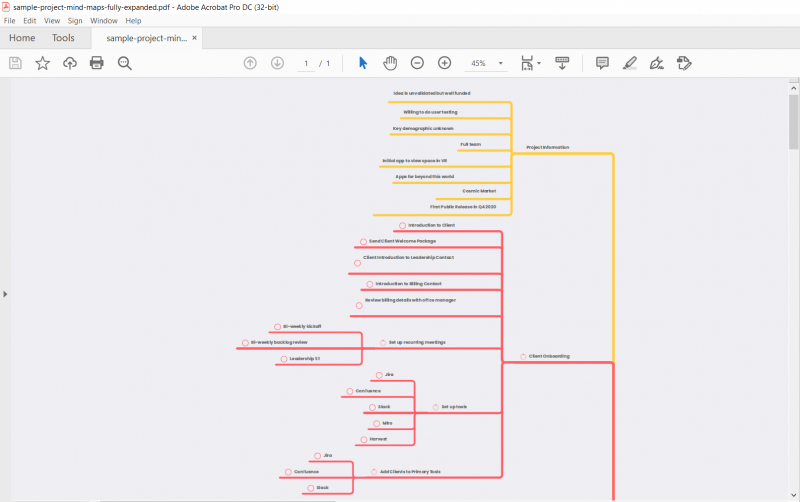Mind mapping is a useful way for project managers to take notes, organize their thoughts, develop new ideas, and even plan projects.
In this article, I'll discuss the purpose of mind mapping and the best software to use for creating maps.
What Is a Mind Map?
A mind map, also known as a concept map or spider diagram, is a visual representation of your thoughts. It can be used to brainstorm ideas, plan projects, or just organize your thoughts. It’s so much more than note-taking; it’s a brain dump with a purpose.
Mind mapping is a way to map out your thoughts and use creative thinking. You start with a central topic or a single word and then add related ideas around it.
Many people are visual learners and are motivated by seeing their ideas come to life. Connecting the dots using a mind map can help you see the big picture and better understand how your thoughts are connected.
This concept has been around since the time of Aristotle—it was used by Porphyry of Tyre in the 3rd century—but was more recently popularized in the 1970s by Tony Buzan, a British popular psychologist. It remains a great tool for visual and creative thinking
Here's how it works:
- Start with a central topic or central image. This could be anything from a problem you're trying to solve to an upcoming project.
- Then, start brainstorming ideas related to that central theme or central concept, known as subtopics. Write down everything that comes to mind, no matter how big or small.
- Next, start connecting the ideas together. See how they relate to each other and start creating a structure for your mind map. You might use color, draw lines, or use some other way to connect ideas.
- Finally, add any additional details or notes that will help you understand the ideas better. This could be anything from definitions to examples.
Mind maps are usually created with a piece of paper and a pen, but many mind mapping software tools are also available. For those who prefer digital tools, there's a variety of free mind mapping software that can be just as effective.
What Is The Purpose Of Mind Mapping?
Mind mapping has been used for centuries to help people think more creatively and come up with new ideas. It’s also helpful when problem-solving because it helps you see the central idea and the sub-branches contributing to your challenge.
It's a great way to brainstorm because it allows you to quickly jot down your thoughts without getting bogged down in the details. Mind maps can also be used to plan projects, organize information, or take notes.
5 Benefits Of Mind Mapping
Some benefits of mind mapping include:
- Brainstorm new ideas
- Organize & improve retention of thoughts and information
- Plan projects
- Take notes
- See the connections between your thoughts
Mind maps help you think more clearly and see the connections between thoughts. Studies have shown that mind mapping can help with generating creative ideas & problem solving, explaining your ideas to others, and remembering & digesting information.
Example Of Mind Maps In Project Management
One way to use mind maps for project manager is to plan the sequence of tasks needed to initiate a project and keep track of what's known and has been completed. Here's how that might look:

In the yellow section, we're keeping track of what we know about the project: the timeline, requirements and notes about the deliverables, and what the project team looks like.
The red section contains all the set up and initiation tasks that must be completed, with a check box next to each so we know what's completed and what's next.
What Is The Best Software To Use For Mind Mapping?
Mind mapping software makes mind mapping easier and more fun. You can quickly add ideas, images, and links to your map. And you don't have to worry about running out of space on a piece of paper. It can help you brainstorm in real time with templates that you can customize for each project.
While each software is a bit different, here are some features you should look for when researching these apps:
- Ability to add images, links, and notes
- Easy to use interface
- Collaboration features
- Printing and export options
Check out our list of the 10 best mind mapping software options to get started. Each of these options has different features and pricing options, so be sure to choose the one that's right for you.
The Digital Project Manager is reader-supported. We may earn a commission when you click through links on our site—learn more about how we stay transparent.
Get Started With Mind Mapping Software
Mind mapping is a flexible tool that can be used for any purpose. There are no rules or limits to what you can include in your map.
To start, you only need a blank page and a pen. But if you want to make mind mapping more fun and easy, many great mind mapping tools are available. Choose the software that's right for you and start brainstorming your next big idea! Plus, get started with these mind mapping techniques.
And if you want to stay up-to-date on all the ways to implement mind mapping into your project management workflow, subscribe to The Digital Project Manager newsletter.


